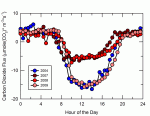On October 24th, 2005, Hurricane Wilma made landfall on the south western shore of the Florida peninsula. This major disturbance destroyed approximately 30 percent of the mangrove forests in the area. However, the damage to the ecosystem following the hurricane provided researchers at the Florida Coastal Everglades (FCE) LTER site with the rare opportunity to track the recovery process of the mangroves as determined by carbon dioxide (CO2) and energy exchanges, measured along daily and seasonal time scales.
The FCE flux tower located in the Everglades National Park, which became operational in 2004 as a means to investigate mangrove forest-atmosphere exchanges of carbon, water, and energy, turned out to be just the right instrument for this important study.
The damaged mangrove forest site provided an ideal setting for studying resiliency and recovery of a forest following a major disturbance. Studies of carbon and energy flows serve as key metrics for forest recovery as these fluxes converge to either pre-disturbance patterns or some new steady state. These flows of carbon, water vapor, and measurable heat between the forest and the atmosphere, were determined with a tower-mounted eddy covariance system.
Following the sudden loss of biomass and leaf area after Wilma, the net ecosystem production (NEP), which is the sum of photosynthetic assimilation and respiratory losses of carbon, was substantially reduced compared to the pre-disturbance value. Nighttime processes of respiration remained relatively constant before and immediately after the disturbance; therefore, the net effect of respiration processes in the ecosystem was not dramatically affected (Figure 1). This result suggests that dead biomass, which remained within the flux footprint, was decomposing slowly and not contributing much to higher ecosystem respiration rates.
Immediately after Wilma, a reduction in carbon sequestration during daytime hours (Figure 1) was attributed to the loss of mangrove biomass and leaf area. This overall reduction of NEP can be observed through several years following the hurricane (Figure 2). Additionally, mortality of the mangroves continued for several years after Wilma while sediment surface elevations decreased, probably due to the decomposition of belowground organic matter. However, the magnitude of NEP following the disturbance (800 to 850 g C m-2 yr-1) was still much greater than those values (mean±1 standard deviation) determined for a global dataset of temperate terrestrial evergreen (398±42 g C m-2 yr-1) and deciduous (311±38 g C m-2 yr-1) forests (Luyssaert et al., 2007).
Still, this disturbed ecosystem is rapidly recovering as evidenced by increases in NEP and leaf area index, and rapid growth of saplings in the forest understory. We continue to track the recovery of the ecosystem structure and function through the metrics of NEP and its components—namely, gross ecosystem production and ecosystem respiration. This study is unraveling some of the mysteries behind mangrove forest recovery through near real-time monitoring of biophysical and microclimatological processes.
Reference
Luyssaert, S., et al. (2007), CO2 balance of boreal, temperate, and tropical forests derived from a global database, Global Change Biology, 13, 2509-2537.

 Enlarge this image
Enlarge this image
